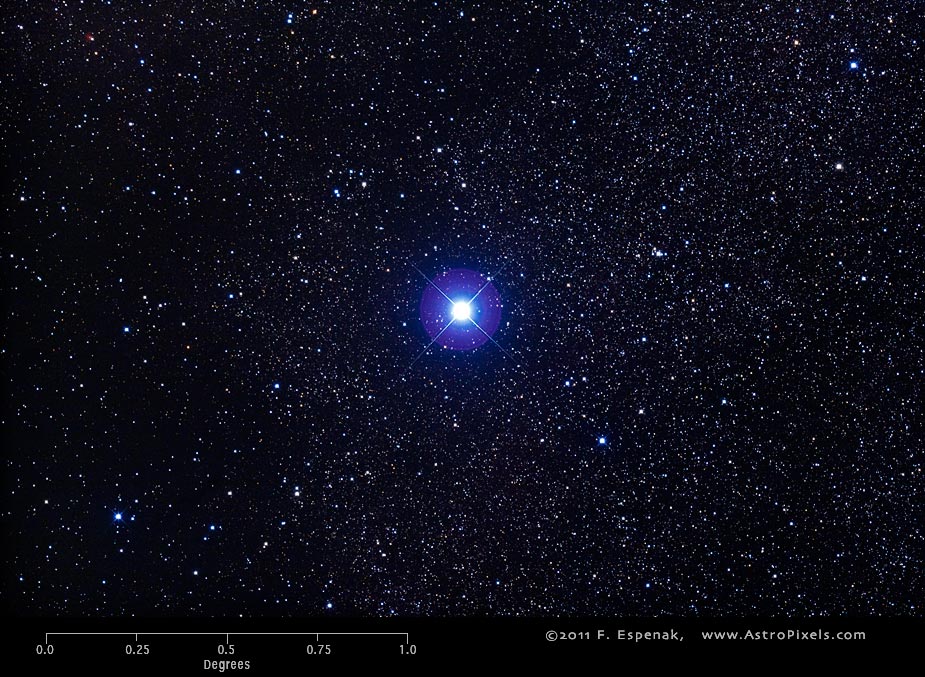Deneb
Deneb or Alpha Cygni (Alp Cyg) is the brightest naked eye star in the constellation Cygnus. With an apparent magnitude of 1.25v, Deneb is the 19th brightest star in the entire sky (see: 50 Brightest Stars ). Its absolute magnitude is -8.73 and its distance is 3230 light years. The Equinox J2000 equatorial coordinates are RA = 20h 41m 25.9s, Dec = +45° 16' 49".
Deneb has a spectral type of A2Ia, a surface temperature of 8525° Kelvin and a luminosity 54,000 times the Sun. It has a mass of 20 solar masses and a diameter 110 times the Sun.
The image above shows the uncropped view of Deneb (North is up) through the Takahashi E-180 Astrograph.
Deneb along with Altair and Vega
form the vertices of the Summer Triangle. With andabsolute magnitude of -7.0, Deneb is among the most intrinsically bright stars known, with an estimated luminosity nearly 60,000 times that of the Sun. Its exact distance is uncertain, which makes determining many of Deneb's other properties similarly imprecise. However, the uncertainty was dramatically reduced upon analysis of the Hipparcos Data Reduction in 2007. One 2008 study puts the most likely distance at 1,550 light-years, with an uncertainty of approximately 10%. The reduced parallax uncertainties do not rule out a distance as close as 1,340 light-years or as far as 1,840 light-years. It is the farthest-known first-magnitude star from Earth.Based on its temperature and luminosity, and also on direct measurements of its tiny angular diameter (a mere 0.002 arcseconds), Deneb appears to have a diameter of about 110 times that of the Sun; if placed at the center of our Solar System, Deneb would extend halfway out to the orbit of the Earth and would appear xxx ° in apparent diameter (the Sun's apparent diameter is 0.5°). Alpha Cygnii is one of the largest white stars known.
As a blue-white supergiant (spectral type A2Ia), Deneb's high mass (20 solar masses) and temperature (8,400° Kelvin) mean that the star will have a short lifespan and will probably go supernova within a few million years. It has already stopped fusing hydrogen in its core. The star was probably an O class star during its main sequence lifetime and is now probably expanding into a red supergiant like Mu Cephei. As it expands, it will go through the F, G, K and M spectral types.
Deneb's solar wind causes it to lose mass at a rate of 0.8 millionth of a solar mass per year, a hundred thousand times the flow rate from the Sun. It is the prototype of a class of variable stars known as Alpha Cygni variables. Its surface undergoes non-radial fluctuations which cause its brightness and spectral type to change slightly.
The description above is based on the Deneb entry in Wikipedia. For more information about Deneb, see Stars (Jim Kaler).
Technical Details
- Object: Deneb
- Other Names: Alpha Cygni, HR7924, HD197345, HIP102098
- Object Type: bright star
- Object Data: Apparent Magnitude = 1.25v, Absolute Magnitude = -8.73, distance = 3230 light years
- Object Position (Equinox J2000): RA = 20h 41m 25.9s, Dec = +45° 16' 49", Constellation = Cygnus
- Date/Time: 2011 Oct 21 at 03:50:28 UTC
- Location: Bifrost Astronomical Observatory, Portal, AZ
- Mount: Astro-Physics 1200GTO
- Telescope: Takahashi Epsilon 180 Hyperbolic Astrograph
- Camera: Canon EOS 550D (Rebel T2i) (modified with a Baader UV/IR filter)
- Field of View: 1.70° x 2.56° at 1.7 arc-sec/pixel (web version: 10.0 arc-sec/pixel)
- Exposure: 2 x 300s, f/2.8, ISO 800
- File Name: Deneb-01w.jpg
- Processing (Adobe Camera Raw): Graduated Filter, Vignetting Correction, Noise Reduction, White Balance, Curves
- Processing (Photoshop CS5): Average Images, Curves, Noise Reduction
- Original Image Size: 3454 × 5179 pixels (17.9 MP); 11.5" x 17.3" @ 300 dpi
- Rights: Copyright 2011 by Fred Espenak. All Rights Reserved. See: Image Licensing.
